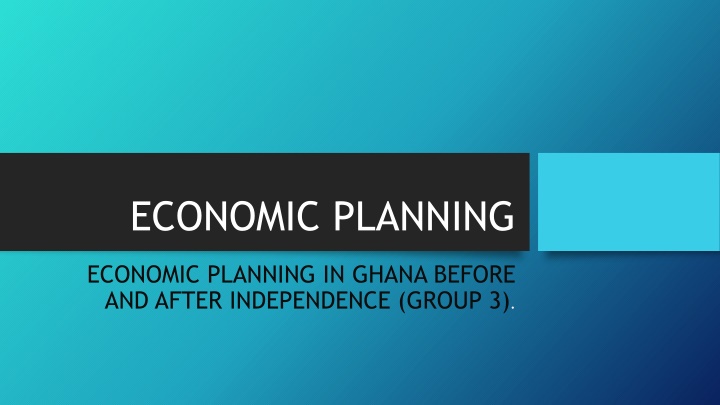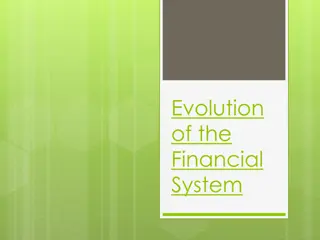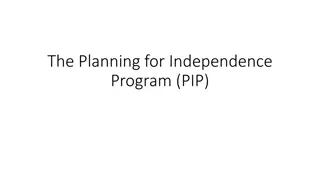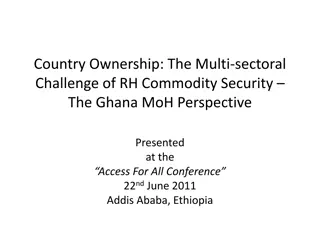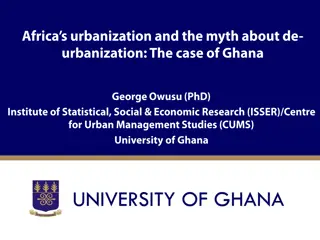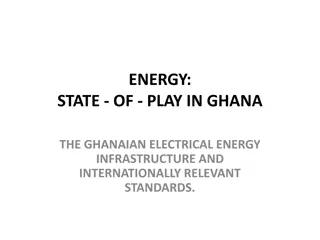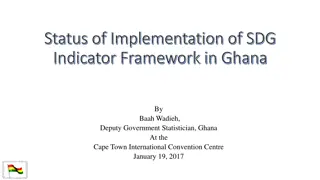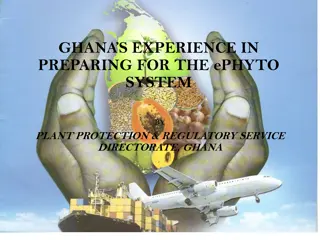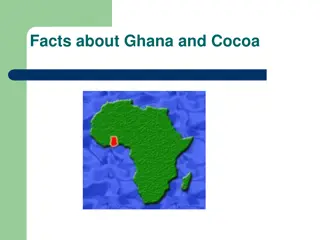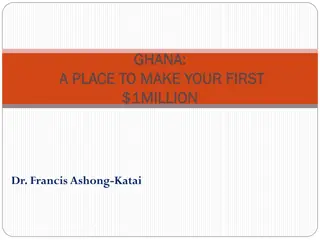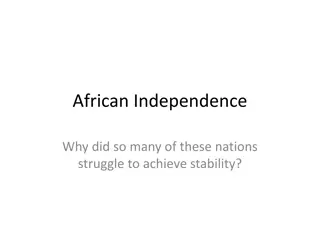Economic Planning in Ghana: Pre and Post Independence
Delve into the economic planning strategies implemented in Ghana before and after independence, exploring key initiatives, limitations, and the impact of decisions on the country's development. Learn about prominent figures like Dr. Regina O. Adutwum and their contributions to shaping Ghana's economic landscape.
Download Presentation

Please find below an Image/Link to download the presentation.
The content on the website is provided AS IS for your information and personal use only. It may not be sold, licensed, or shared on other websites without obtaining consent from the author.If you encounter any issues during the download, it is possible that the publisher has removed the file from their server.
You are allowed to download the files provided on this website for personal or commercial use, subject to the condition that they are used lawfully. All files are the property of their respective owners.
The content on the website is provided AS IS for your information and personal use only. It may not be sold, licensed, or shared on other websites without obtaining consent from the author.
E N D
Presentation Transcript
ECONOMIC PLANNING ECONOMIC PLANNING IN GHANA BEFORE AND AFTER INDEPENDENCE (GROUP 3).
OBJECTIVES By the end of this presentation/lecture , we should be able to understand; Economic planning in Ghana before independence. Economic planning in Ghana after independence. Some limitations to and problems of economic planning in Ghana.
TOPIC OUTLINE Aims/objectives 1. Biography of Dr. Regina O. Adutwum 2. Economic plans of Ghana before independence a. Guggisberg s ten year development plan b. Nkrumah s ten year economic and social development plan.
TOPIC OUTLINE Aims/objectives 3. Economic plans after independence a. Nkrumah s seven year development plan b. Achaempong s five year development plan c. Vision 2020
TOPIC OUTLINE Aims/objectives ctd . 3. Economic plans after independence d. The coordinated programme for Economic and Social Development of Ghana (2003-2012) e. The coordinated programme for Economic and Social Development of Ghana (2010-2016) f. The Coordinated Programme for Economic and Social Development of Ghana (2014-2020)
BIOGRAPHY OF REGINA O. ADUTWUM
BIOGRAPHY OF REGINA O. ADUTWUM Dr. Regina O. Adutwum is the Director General of the National Development Planning Committee (NDPC) since the year 2006. She holds a PHD in Agriculture and Economics. She was a member of W.H.O, GIMPA,ISSER,CSIR just to mention a few. Contributing to economic planning in Ghana, she made a statement that, the world we live in today is as a result of certain decisions made yesterday. And the world we will have tomorrow will be base on the decisions we make today All of us are contributors to the statement above.
BIOGRAPHY OF REGINA O. ADUTWUM Hence contributing to economic development in Ghana as a country, it can be said that certain decisions made by previous governments in power, are the causes of certain circumstances and crisis we find ourselves in as citizens of the country. Also, it will be to the benefit of Ghanaians in the near future if certain drastic, efficient and effective decisions are taken presently, since the decisions of today affect the future.
ECONOMIC PLANNING IN GHANA BEFORE INDEPENDENCE.
Guggisbergs 10-Year Development Plan (1920-1930) This happens to be the first development plan to have been embarked upon in Ghana (the then Gold coast). It was 10 year development plan initiated by Sir Gordon Guggisberg under his colonial governorship in 1919. It was projected to last for ten years that from 1920 to 930 but lasted for 7 years. The plan was aimed to cover areas like physical infrastructure, social services and agriculture.
Guggisbergs 10-Year Development Plan (1920 1930) The physical infrastructure included: 1) 333km new railway to link mining areas 2) construction of road networks 3) development of water supply system and Takoradi Harbour. The social services consisted of Achimota school formally known as Prince of Wales School construction of Korle-Bu teaching Hospital, Tarkwa Hospital and 17 other hospitals. Expansion of agricultural inputs to enhance production. 4) construction of 1) establishment of 2)
Nkrumahs 10-Year Development Plan (1951-1961) The next major attempt at planning after Guggisberg Plan was the drafting of another 10-Year Development Plan (1946-1956) which was launched in 1951. The plan primarily sought to enhance infrastructure (development) and social services (welfare augmentation). During the period, the self-government campaign initiated by Nkrumah s C.P.P which had gained ground by the 1950s led to the election of the first African majority of government in 1951. This was shortly after the introduction of the 10-Year Plan of Development and Welfare. Consequently, Nkrumah s C.P.P government decided to transform the ongoing 10-Year Plan of Development and Welfare into a 10-Year Plan for Economic and Social Development of the Gold Coast (1951-1961) which was to be phased into two 5-year plans instead of 10-year, although considerable additions were made to the original plan (i.e 1946-1956), the basic structure of the plan remained unchanged
Nkrumahs 10-Year Development Plan (1951-1961) The plan was supposed to use 74 million as the implementation fund. In terms of implementation, it operated from 1951 to 1956 because it coincided with the independence of Ghana. Then from 1958 to 1959, there was the consolidated plan aimed at putting things together in preparation for the second 5-Year plan, which existed between 1959 and 1964.
ECONOMIC PLANNING IN GHANA AFTER INDEPENDENCE
Nkrumahs 7-Year Development Plan (1963-1970) This plan was the most comprehensive developmental plan to be made in Ghana because it almost covered all the major sectors of the economy. The basic aim of the plan was to modernize agriculture and develop industry on the basis of a socialist society. The plan was to operate under the politico-economic philosophy of work and happiness. Included in the plan were (i)Extensive infrastructure development: Tema Township, Tema Motorway, Tema Harbour, Akosombo Dam (ii) Massive development of education such as the establishment of KNUST and 26 secondary schools under the Trust Schools Scheme (for example, Ghana National College, Sunyani Secondary School, Dormaa Secondary School, Mfantseman, Asankragua, St.Johns, and many others. (iii) Establishment of several factories
Nkrumahs 7-Year Development Plan (1963-1970) The plan did not experience its full realization due to: Heavy dependence on the unpredictable weather conditions resulting in low agricultural output and this problem still persisted in the development process. unfavorable terms of trade for its major export earner cocoa. controversy between the technocrats (economists) and the politicians on certain policy areas. situation in which, instead of raising the capacity levels of existing enterprises, new enterprises, which were not included in the plan, were established. no requisite Cost Benefit Analysis (i.e. feasibility studies) in undertaking projects and nepotism in the award of contracts.
Acheampongs 5-Year Development Plan (1975-1980) The Plan was formulated to tackle three problems: (i) the high level of unemployment in the system; (ii) the persistent balance of payments (BOP) deficits and (iii) the inflationary pressures in the economy. The primary aim of the plan was to build an independent national economy which would be firmly structured on the potentials of the economy in line with Acheampong s philosophy of self-reliance. These were the specific goals: To accelerate the growth of real GDP. An average growth rate of 5.5% per annum of real GDP was envisioned. To ensure the full employment of the nation s human and natural resources. To ensure equal distribution of the cedi through the control of rapid inflation. To create effective links between sectors of the economy so that development becomes all round.
Acheampongs 5-Year Development Plan (1975-1980) The targets set in the plan were not fully accomplished. Factors which accounted for the plan failure included: Delay in the launching of the plan; it was not until April 1977 that the plan came into effect, thus the growth targets announced as early as 1975 could have not(not have) been achieved. Constant fluctuations in price of primary products The inability of the industrial sector to expand enough to absorb the products from agricultural sector. The price elasticity of cocoa was low High rates of inflation; in some cases reaching 3-digits as in 1977 where inflation reached 117.6%. Such high rates of inflation raised the cost of implementing the projects.
CONSOLIDATED PROGRAMME FOR ECONOMIC AND SOCIAL DEVELOPMENT OF GHANA
Vision 2020 (1996-2020) This was not necessarily a development plan but a policy document introduced to enable Ghana to become a middle-income country by 2020. It consisted of two phases, that is, the consolidated period or medium term (1996-2000) and long period (2001-2020). Consolidation period (1996-2000) This period was supposed to consolidate the gains made from the last decade (1986- 1995) and also to lay strong foundation for accelerated growth and development in the subsequent two decades. Hence this medium-term coordinated programme of policies represented the first step towards the achievement of the goals in VISION 2020. The document sought among other things to achieve the following as its medium- term objectives: i. To better social conditions in terms of education, health and other social amenities in the economy. ii. improving upon the exchange rate and the level of inflation aimed at increasing annual GDP.
Vision 2020 Contd . agricultural products iv. To fully utilize the modern concept of science and technology which have become the driving force of modern economies. v. To improve upon the existing level of infrastructure, environment and public administration. vi. To ensure that small and medium-sized towns adequately fulfill their role as service centers for rural hinterland, and that the process of urbanization will contribute positively to economic development vii. To create the enabling environment in which all sectors of the economy would contribute to sustained and accelerated growth rate in social and economic development. viii. Before the end of the consolidation period (i.e within the first five years, 1995-2000), VISION 2020 had become a total disappointment; all the targets set could not be achieved. To improve upon the production, processing and marketing of
Vision 2020 Contd The long-term period (2001-2020) The objectives of the long-term period were: I. Growth rate of the population should by 2% by 2020 to enhance human development. II. To create the necessary environment to promote investment thereby enhancing economic growth targeted at over 8% by 2020 III. Reduce disparities between the rural and the urban centers, in order to improve human live of the rural folks. IV. To ensure that small and medium-sized towns adequately fulfill their role as service centers for rural hinterland, and that the process of urbanization will contribute positively to economic development
Vision 2020 Contd To create the enabling environment in which all sectors of the economy contribute to economic and social development.
The Coordinated Programme for Economic and Social Development of Ghana (2003-2012) Like vision 2020, the coordinated programme for Economic and Social Development of Ghana (2003-2012) sometimes referred to, as the VISION 2012 was not strictly a development plan. It was a policy framework designed by the NPP administration to make Ghana a middle-income country by the year 2012. A significant milestone along the path to becoming a middle-income country was obtaining a per capita income of US$1000 within the time period 2003-2012. To make this feat achievable, the first step is to double our current national income within a decade
The Coordinated Programme for Economic and Social Development of Ghana (2003-2012) Ctd There are two sets of development objectives enshrined in the document: i. Laying down the foundations of accelerated development ii. The long-term programmes that will push the economy into a higher developed state , therefore moving accelerated growth path. the economy into a sustained Foundation of the Plan In the national quest for accelerated growth, there is the need to build a strong and unshakable socio-economic foundation
The Coordinated Programme for Economic and Social Development of Ghana (2003-2012) Ctd The foundation building strategies and objectives are also contained in the Ghana Poverty Reduction Strategy (GPRS) as the Medium-Term Strategies include: i. Enhanced Infrastructure ii. Rural Development based on the modernization of agriculture iii. Enhanced Social Services iv. Good Governance v. Private Sector Development
The Coordinated Programme for Economic and Social Development of Ghana (2010-2016) The aim of this programme was to rapidly transform the structure of the Ghanaian economy while speeding on poverty reduction in the country. Ultimately to put all development plans as one, particularly the Growth and Poverty Reduction Strategy (GPRS II) which was a medium term plan. The 10-year development plan focused on four key areas; i. Industrial development for a small open economy ii. Modernizing agriculture iii. Human capital development for structural transformation of Ghana s economy iv. Human settlement for a changing economy.
The Coordinated Programme for Economic and Social Development of Ghana (2010-2016) ctd This Programme was a strategic for directing national aspirations towards accelerated industrial development and was to guide the execution of development policy and related activities at all levels of the governance structure. The immediate objective I. To make extreme forms of deprivation, such as hunger, homelessness, and poverty be a thing of the past. II. Economic growth will be environmentally sensitive and public policy to ensure equality among all sectors of the economy. III. Industrial production with full participation of Ghanaians IV. Affordable and available healthcare services and quality education.
The Coordinated Programme for Economic and Social Development of Ghana (2010-2016) ctd iv. Quality and available jobs for employable youth. v. Undertaking Science, technology and innovation activities which underline the solution of the nation s problems to speed up advancement; and vi. Equality in sharing national progress by all citizens.
The Coordinated Programme for Economic and Social Development of Ghana (2014-2020) The plan/programme was specifically set out to achieve the target of the socio-economic transformation proposed in Advancing the Better Ghana Agenda launched in 2012 through designed policies, strategies, rules and regulations. Furthermore, To move from a lower middle income economy to an upper middle income economy, that is, with the average national income moving from US$1,550 to the range of US$7,500 to US$10,000.
The Coordinated Programme for Economic and Social Development of Ghana (2014-2020) ctd The following will constitute the hallmarks of a transformed and resilient Ghanaian economy under this Programme: i. Improving agricultural sector productive sector through science and technology and engaging in the local and international market activities. ii. Creating an efficient, competitive and flexible private sector with greater focus on small-and-medium enterprises. iii. Infrastructure development transportation, utilities, ICT networks. into a modern and highly such as various forms of
The Coordinated Programme for Economic and Social Development of Ghana (2014-2020) ctd2 iv. An established government-private sector friendship that results in opportunities for local citizens businesses both locally and internationally. v. A peaceful atmosphere in the industrial sector among the labor , employers and government. vi. A light-manufacturing sector that lays the groundwork for a broader and globally competitive industrial sector in the long term.
CTD vii. A 21st labor force that is knowledgeable, highly skilled, healthy, and globally competitive; viii. A responsible and responsive citizenry who are disciplined, hardworking and dedicated to their broad civic responsibilities.
REASONS FOR THE PLAN FAILURES
1. Lack of political will. 2. Weaknesses of institutions such as organizational problems and departmental rivalries. 3. Unanticipated economic and political disturbances. 4. Insufficiency and unreliable data. This is due to inadequate supply of qualified economists , and other planning personnel.
REFERENCES International Relations and Diplomacy, ISSN 2328-2134 November 2013, Vol. 1, No. 2, 93-107. www.justiceghana.com/indexphp/en/ National Development Planning Commission, Ghana Distance education learning materials.
